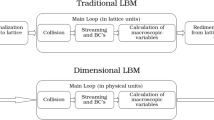Abstract
A numerical study of the two-dimensional isothermal steady flow distribution of an incompressible fluid in the shell side of an experimental heat exchanger is described.
Computations are performed with and without tubes present in the model, for Reynolds numbers up to 10,000. Baffles and tube bundles are modelled by incorporating the “porous medium” concept into the governing equations.
The resulting equations described in primitive variables are solved using a semi-implicit predictor-corrector type scheme. A Multi-Grid technique is employed to solve the linearized pressure correction equation which links momentum and continuity equations. Predictions with the proposed scheme indicate good qualitative agreement when compared with experimental measurements.
Similar content being viewed by others
Abbreviations
- A :
-
area of a control volume face
- A out :
-
outlet area of heat exchanger model
- a p , a E , a W , a N , a s :
-
coefficients of finite volume equations
- b e , b n :
-
constant part of linerized source term in momentum equations
- C μ :
-
constant in turbulence model (= 0.09)
- d t :
-
tube diameter
- d h :
-
hydraulic diameter
- E :
-
constant factor
- F x i (i = 1, 2):
-
momentum equations source term
- fc :
-
cross flow friction factor
- fp :
-
parallel flow friction factor
- K b :
-
baffle resistance to flow
- Ku 1, Ku 2 :
-
loss coefficients
- l :
-
average length scale (= 1/2 (2p - d t ) for tube filled; = L m for tube free)
- L :
-
characteristic length (= side of square cavity, or, = L in )
- L in :
-
inlet length
- p :
-
tube pitch
- P :
-
pressure
- P * :
-
best estimate of pressure
- P′:
-
pressure correction
- Re :
-
Reynolds number (Re = L × V/v)
- S :
-
linearized source term
- t :
-
time
- U 1, U 2 :
-
velocity components in x 1− and x 2-direction, respectively
- U *1 , U *2 :
-
velocities based on P *
- U 2 o :
-
normal velocity component at outlet
- U 2 0–1 :
-
normal velocity component just before the outlet
- U in :
-
inlet velocity
- V :
-
reference velocity (= velocity of moving lid for cavity flow, or, = U in )
- x i (i = 1,2):
-
cartesian coordinates
- X i (i = 1,2):
-
normalized cartesian coordinates
- β:
-
local volume porosity = fluid volume/total volume)
- β t :
-
porosity within the tube bundle
- Δm :
-
inflow/outflow mass imbalance
- Δ:
-
time step
- (Δt) max :
-
maximum time step for an explicit formulation
- ΔV :
-
volume of control domain
- Δx 1, Δx 2 :
-
dimensions of control domain
- v :
-
laminar kinematic viscosity
- v eff :
-
effective kinematic viscosity
- v t :
-
turbulent kinematic viscosity
- ϱ:
-
density of fluid
- Σ:
-
summation
- φ:
-
general dependent variable
- nb :
-
nodal locations adjacent to e (or n) location
References
Brandt, A. (1977): Multi-level adaptive solutions to boundary value problems. Math. Comp. 31, 333 -390
Butterworth, D. (1980): Unresolved problems in heat exchanger design. I. Chem. E. Symp. Ser. 60, 231–248
Carver, M. B.; Carlucci, L. N.; Inch, W. R. (1981): Thermal-hydraulics in recirculating steam generators. Atomic Energy of Canada Limited (CRNL), Report AECL-7254
Elphick, I. G.; Martin, W. W. (1982): Flow distribution measurements in a model heat exchanger, phase 1, Report Laser Doppler Anemometry Laboratory, University of Toronto, 1982
Holloway, A. G. L.; Tavoularis, S. (1985): On turbulence modelling of industrial heat exchanger flows. In: Rasmussen, H. (ed.): Proceedings of the Tenth Canadian Congress of Applied Mechanics, vol. 2, pp. B117-B118. London (Ont.): U. Western Ontario
Pataknar, S. V.; Spalding, D. B. (1974): A calculation procedure for the transient and steady-state behavior of a shell-andtube heat exchangers. In: Afgan, N. H. and Schlunder, E. V. (eds.): Heat exchangers — design and theory source book, pp. 155–176. New York: McGraw-Hill
Patankar, S. V. (1980): Numerical heat transfer and fluid flow. Washington: Hemisphere
Rhodes, D. B.; Carlucci, L. N. (1984): Predicted and measured velocity distributions in a model heat exchanger. Atomic Energy of Canda Limited (CRNL), Rpt. AECL-8271
Sha, W. T. (1979): Summary of methods used in rod-bundle thermal hydraulic analysis. In: Kakac, S. and Spalding, D. B. (eds.): Turbulent forced convection in channels and bundles, vol. 1, pp. 279–299. New York: Hemisphere
Sousa, A. C. M.; Venart, J. E. S.; Khan, A. M. (1983): Free convective recirculating flows due to localized heat sources. ASME: Heat transfer in recirculating flows, Paper 83-WA/HT-12
Sousa, A. C. M.; Hadjisophocleous, G. V. (1985): Numerical studies of convective flow driven by discrete sources. In: Taylor, C., Olson, M. D., Gresho, P. M. and Habashi, W. G. (eds.): Numerical methods in laminar and turbulent flow, part 1, pp. 901–912. Swansea: Pineridge Press
Theodossiou, V. M.; Sousa, A. C. M. (1986): An efficient algorithm for solving the incompressible fluid flow equations. Int. J. Numer. Meth. Fluids 6, 557–572
Van Doormaal, J. P.; Raithby, G. D. (1984): Enhancements of the Simple method for predicting incompressible fluid flows, Numer. Heat Transfer 7, 147–163
Author information
Authors and Affiliations
Additional information
Communicated by S. N. Atluri April 22, 1987
Rights and permissions
About this article
Cite this article
Theodossiou, V.M., Sousa, A.C.M. & Carlucci, L.N. Flow field predictions in a model heat exchanger. Computational Mechanics 3, 419–428 (1988). https://doi.org/10.1007/BF00301142
Issue Date:
DOI: https://doi.org/10.1007/BF00301142




